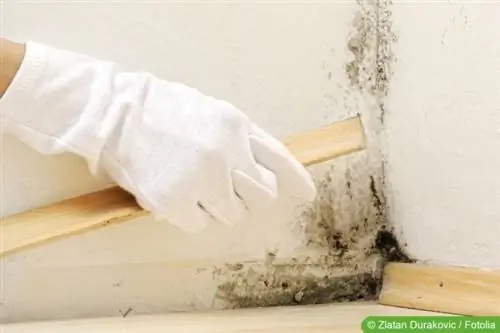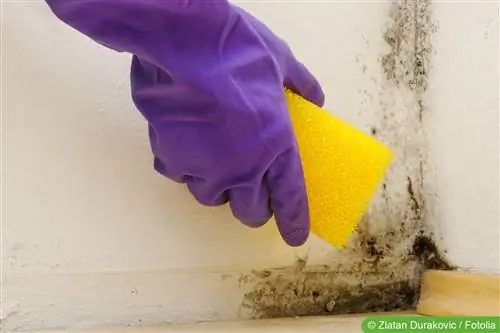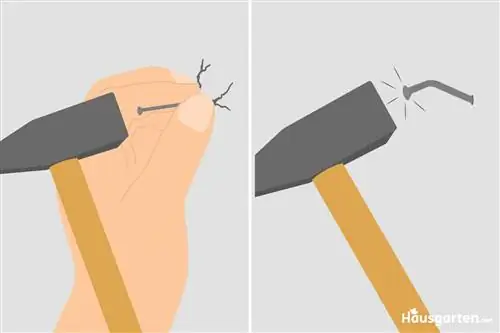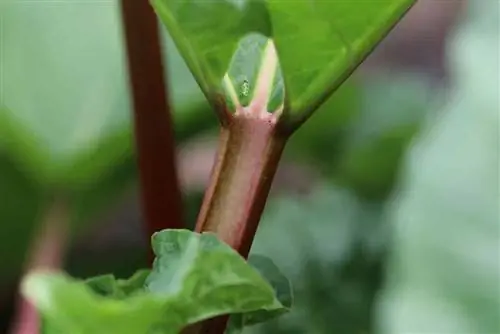- Author admin [email protected].
- Public 2023-12-17 03:39.
- Last modified 2025-01-24 12:45.
Chlorine can effectively combat mold, but it is not without danger. In practical use, some safety measures are therefore necessary in order not to cause any damage to he alth or take unnecessary risks. We show what is important when removing mold with chlorine.
Benefits of Chlorine
Using chlorine against mold makes sense for many reasons. These key advantages include the following points:
- easy to use
- cost-effective remedy
- fast and comprehensive effect
- effective against germs
Chlorine kills all components of the mold. This means that it is often enough to apply the product once. However, the prerequisite for this is that the cause of the mold has been eliminated.
Disadvantages of chlorine
Chlorine puts a strain on the respiratory tract and can burn the skin. This already applies to simple and approved solutions. For this reason, precautionary measures must always be taken when using it.
There is a particularly high risk when mixed with other cleaning agents or mold removal products. The resulting chemical reactions can produce chlorine gas. This is acutely toxic. Even small amounts irritate the airways when inhaled and can lead to serious lung damage.
Tip:
Another potential disadvantage of chlorine is the possible damage to the material. It should therefore only be used on suitable surfaces.
Safety measures
Due to the potential dangers of using chlorine against mold, appropriate safety measures must be taken.
- Use breathing mask
- ventilate the affected room continuously
- Do not mix chlorine with other substances
- Wear gloves
Note:
If other products or specifically mold removers have already been used on the affected area, chlorine should no longer be used. Even the seemingly harmless combination of chlorine and vinegar creates chlorine gas.
Application
The application depends on which material and which area needs to be treated. If mold has formed on washable textiles, the procedure is different than with furniture or a wall. Nevertheless, the application can be carried out quickly and easily in any case.
Textiles
Washable textiles with mildew or mold stains can possibly be saved if they are treated with chlorine. The following procedure is recommended:
- soak in chlorine-water mixture
- wash several times with added chlorine
- connect normal wash cycles
It should be noted that chlorine has a bleaching effect. It is therefore only suitable for white textiles.
Plastic
Porous plastic should not be treated with chlorine. However, this is possible without any problems with smooth variants.
When used, the cleaning agent should be absorbed straight into rough surfaces and the mold should be allowed to move away. Unlike spraying, no spores are stirred up and distributed in the environment. It is ideal to moisten the affected area in advance with a wet cloth and then spray it with chlorine or place a cloth soaked in chlorine on it.

After the exposure time, wipe several times with pure water. If possible, chlorine residues should be rinsed away.
With rough plastic, it may also be necessary to brush mold residue from the grooves and repeat the process several times if necessary.
Wood
Mold on wood is occasionally found on garden furniture. Much more often, it comes from moldy walls and can then be found, for example, on the side panels or back walls of cupboards.
As long as the infestation is only superficial, both chlorine and hydrogen peroxide are suitable for removal. The products can only be used individually, but both have bleaching effects. This lightens the dark mold discoloration.
In the first step, the wood is moistened again with a cloth to avoid stirring up spores. Chlorine can then be sprayed on or the area can be soaked and then wiped with pure water.
Wallpaper and plaster
Lack of heating, incorrect ventilation, leaky pipes or insulation - mold on the walls, in corners of rooms or on the ceiling is unfortunately not uncommon and often goes unnoticed for a long time. This is especially true if it is behind cupboards or on window frames. Infestations often progress very far before treatment is provided. The fight against it must be correspondingly comprehensive.
In addition, this only makes sense if the cause is known and has been remedied. If there is a leaky shower, water pipe or a damaged facade with moisture penetrating from outside, chlorine will only provide a short-term improvement. However, the mold then continues to spread.

A small amount of infestation on the wallpaper or plaster is first wiped with a damp cloth and then sprayed thoroughly with chlorine. Visible mold residues are dabbed off.
If there is significant spread, it is necessary to remove the wallpaper and, if necessary, remove plaster. Only then can treatment with chlorine be carried out to kill any spores that may be present. After it has completely dried, the renovation can be carried out.
Frequently asked questions
What alternatives are there for chlorine against mold?
Hydrogen peroxide and vinegar solutions can stop the spread and eliminate mold. An ozone generator can also be used to kill spores that are already in the area. In any case, it is important to eliminate the cause of the mold so that it does not become infested again.
Is a mold remover enough?
There are now numerous products on the market to combat and remove mold. Whether a single agent is sufficient or multiple applications are necessary depends, among other things, on the severity of the infestation. If mold spreads significantly or forms again, it is important to eliminate the cause and carry out comprehensive treatment.
When is mold removal a task for skilled workers?
In the case of severe infestations, it may be necessary to remove wallpaper and plaster and dispose of them professionally and to kill the spores. Due to the effort involved, it is advisable to have it taken over by a company. Professional removal of mold also makes sense if there are already he alth problems and special care must therefore be taken.






